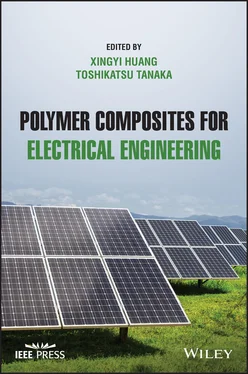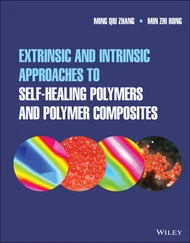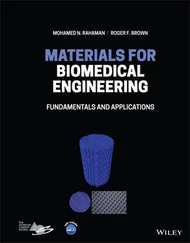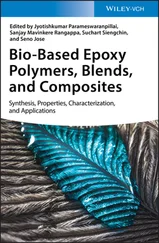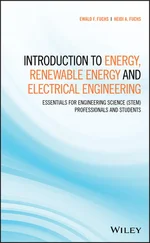Polymer Composites for Electrical Engineering
Здесь есть возможность читать онлайн «Polymer Composites for Electrical Engineering» — ознакомительный отрывок электронной книги совершенно бесплатно, а после прочтения отрывка купить полную версию. В некоторых случаях можно слушать аудио, скачать через торрент в формате fb2 и присутствует краткое содержание. Жанр: unrecognised, на английском языке. Описание произведения, (предисловие) а так же отзывы посетителей доступны на портале библиотеки ЛибКат.
- Название:Polymer Composites for Electrical Engineering
- Автор:
- Жанр:
- Год:неизвестен
- ISBN:нет данных
- Рейтинг книги:5 / 5. Голосов: 1
-
Избранное:Добавить в избранное
- Отзывы:
-
Ваша оценка:
- 100
- 1
- 2
- 3
- 4
- 5
Polymer Composites for Electrical Engineering: краткое содержание, описание и аннотация
Предлагаем к чтению аннотацию, описание, краткое содержание или предисловие (зависит от того, что написал сам автор книги «Polymer Composites for Electrical Engineering»). Если вы не нашли необходимую информацию о книге — напишите в комментариях, мы постараемся отыскать её.
Polymer Composites for Electrical Engineering
Polymer Composites for Electrical Engineering
Polymer Composites for Electrical Engineering — читать онлайн ознакомительный отрывок
Ниже представлен текст книги, разбитый по страницам. Система сохранения места последней прочитанной страницы, позволяет с удобством читать онлайн бесплатно книгу «Polymer Composites for Electrical Engineering», без необходимости каждый раз заново искать на чём Вы остановились. Поставьте закладку, и сможете в любой момент перейти на страницу, на которой закончили чтение.
Интервал:
Закладка:
70 70 Tang, L., Zhao, X., Feng, C. et al. (2019). Bacterial cellulose/MXene hybrid aerogels for photodriven shape‐stabilized composite phase change materials. Solar Energy Materials and Solar Cells 203: 110174.
71 71 Du, X., Qiu, J., Deng, S. et al. (2020). Flame‐retardant and form‐stable phase change composites based on black phosphorus nanosheets/cellulose nanofiber aerogels with extremely high energy storage density and superior solar‐thermal conversion efficiency. Journal of Materials Chemistry A 8: 14126–14134.
72 72 Fallahi, A., Guldentops, G., Tao, M. et al. (2017). Review on solid–solid phase change materials for thermal energy storage: molecular structure and thermal properties. Applied Thermal Engineering 127: 1427–1441.
73 73 Xi, P., Xia, L., Fei, P. et al. (2012). Preparation and performance of a novel thermoplastics polyurethane solid–solid phase change materials for energy storage. Solar Energy Materials and Solar Cells 102: 36–43.
74 74 Fu, X., Xiao, Y., Hu, K. et al. (2016). Thermosetting solid–solid phase change materials composed of poly(ethylene glycol)‐based two components: flexible application for thermal energy storage. Chemical Engineering Journal 291: 138–148.
75 75 Zhou, Y., Liu, X., Sheng, D. et al. (2018). Polyurethane‐based solid–solid phase change materials with in situ reduced graphene oxide for light‐thermal energy conversion and storage. Chemical Engineering Journal 338: 117–125.
76 76 Meng, Q. and Hu, J. (2008). A poly(ethylene glycol)‐based smart phase change material. Solar Energy Materials and Solar Cells 92: 1260–1268.
77 77 Xi, P., Zhao, F., Fu, P. et al. (2014). Synthesis, characterization, and thermal energy storage properties of a novel thermoplastic polyurethane phase change material. Materials Letters 121: 15–18.
78 78 Du, X., Wang, H., Wu, Y. et al. (2017). Solid–solid phase‐change materials based on hyperbranched polyurethane for thermal energy storage. Journal of Applied Polymer Science 134: 45014.
79 79 Lu, X., Fang, C., Sheng, X. et al. (2019). One‐step and solvent‐free synthesis of polyethylene glycol‐based polyurethane as solid–solid phase change materials for solar thermal energy storage. Industrial & Engineering Chemistry Research 58: 3024–3032.
80 80 Yang, J., Tang, L.‐S., Bai, L. et al. (2019). High‐performance composite phase change materials for energy conversion based on macroscopically three‐dimensional structural materials. Materials Horizons 6: 250–273.
81 81 Han, Z. and Fina, A. (2011). Thermal conductivity of carbon nanotubes and their polymer nanocomposites: a review. Progress in Polymer Science 36: 914–944.
82 82 Burger, N., Laachachi, A., Ferriol, M. et al. (2016). Review of thermal conductivity in composites: mechanisms, parameters and theory. Progress in Polymer Science 61: 1–28.
83 83 Apostolopoulou‐Kalkavoura, V., Munier, P., and Bergstrom, L. (2021). Thermally insulating nanocellulose‐based materials. Advanced Materials 33: 2001839.
84 84 Qian, T., Li, J., Min, X. et al. (2015). Enhanced thermal conductivity of PEG/diatomite shape‐stabilized phase change materials with Ag nanoparticles for thermal energy storage. Journal of Materials Chemistry A 3: 8526–8536.
85 85 Tang, B., Qiu, M., and Zhang, S. (2012). Thermal conductivity enhancement of PEG/SiO2 composite PCM by in situ Cu doping. Solar Energy Materials and Solar Cells 105: 242–248.
86 86 Zhang, L., An, L., Wang, Y. et al. (2019). Thermal enhancement and shape stabilization of a phase‐change energy‐storage material via copper nanowire aerogel. Chemical Engineering Journal 373: 857–869.
87 87 Zhang, L. and Feng, G. (2020). A one‐step‐assembled three‐dimensional network of silver/polyvinylpyrrolidone (PVP) nanowires and its application in energy storage. Nanoscale 12: 10573–10583.
88 88 Wang, Y., Tang, B., and Zhang, S. (2013). Single‐walled carbon nanotube/phase change material composites: sunlight‐driven, reversible, form‐stable phase transitions for solar thermal energy storage. Advanced Functional Materials 23: 4354–4360.
89 89 Qian, T., Zhu, S., Wang, H. et al. (2019). Comparative study of single‐walled carbon nanotubes and graphene nanoplatelets for improving the thermal conductivity and solar‐to‐light conversion of PEG‐infiltrated phase‐change material composites. ACS Sustainable Chemistry & Engineering 7: 2446–2458.
90 90 Qian, T., Li, J., Feng, W., and Nian, H.E. (2017). Single‐walled carbon nanotube for shape stabilization and enhanced phase change heat transfer of polyethylene glycol phase change material. Energy Conversion and Management 143: 96–108.
91 91 Liu, Z., Wei, H., Tang, B. et al. (2018). Novel light–driven CF/PEG/SiO2 composite phase change materials with high thermal conductivity. Solar Energy Materials and Solar Cells 174: 538–544.
92 92 Qi, G.‐Q., Yang, J., Bao, R.‐Y. et al. (2015). Enhanced comprehensive performance of polyethylene glycol based phase change material with hybrid graphene nanomaterials for thermal energy storage. Carbon 88: 196–205.
93 93 He, L., Wang, H., Yang, F., and Zhu, H. (2018). Preparation and properties of polyethylene glycol/unsaturated polyester resin/graphene nanoplates composites as form‐stable phase change materials. Thermochimica Acta 665: 43–52.
94 94 Qian, Y., Han, N., Zhang, Z. et al. (2019). Enhanced thermal‐to‐flexible phase change materials based on cellulose/modified graphene composites for thermal management of solar energy. ACS Applied Materials & Interfaces 11: 45832–45843.
95 95 Wei, X., Xue, F., Qi, X. et al. (2019). Photo‐ and electro‐responsive phase change materials based on highly anisotropic microcrystalline cellulose/graphene nanoplatelet structure. Applied Energy 236: 70–80.
96 96 Wu, H., Deng, S., Shao, Y. et al. (2019). Multiresponsive shape‐adaptable phase change materials with cellulose nanofiber/graphene nanoplatelet hybrid‐coated melamine foam for light/electro‐to‐thermal energy storage and utilization. ACS Applied Materials & Interfaces 11: 46851–46863.
97 97 Zhang, X., Liu, H., Huang, Z. et al. (2016). Preparation and characterization of the properties of polyethylene glycol @ Si3 N4 nanowires as phase‐change materials. Chemical Engineering Journal 301: 229–237.
98 98 Wang, W., Yang, X., Fang, Y. et al. (2009). Enhanced thermal conductivity and thermal performance of form‐stable composite phase change materials by using β‐Aluminum nitride. Applied Energy 86: 1196–1200.
99 99 Tang, B., Wu, C., Qiu, M. et al. (2014). PEG/SiO2–Al2O3 hybrid form‐stable phase change materials with enhanced thermal conductivity. Materials Chemistry and Physics 144: 162–167.
100 100 Deng, Y., Li, J., and Nian, H. (2018). Polyethylene glycol‐enwrapped silicon carbide nanowires network/expanded vermiculite composite phase change materials: form‐stabilization, thermal energy storage behavior and thermal conductivity enhancement. Solar Energy Materials and Solar Cells 174: 283–291.
101 101 Luo, F., Yan, P., Qian, Q. et al. (2020). Highly thermally conductive phase change composites for thermal energy storage featuring shape memory. Composites Part A: Applied Science and Manufacturing 129: 105706.
102 102 Fang, H., Lin, J., Zhang, L. et al. (2020). Fibrous form‐stable phase change materials with high thermal conductivity fabricated by interfacial polyelectrolyte complex spinning. Carbohydrate Polymers 249: 116836.
103 103 Jia, X., Li, Q., Ao, C. et al. (2020). High thermal conductive shape‐stabilized phase change materials of polyethylene glycol/boron nitride@chitosan composites for thermal energy storage. Composites Part A: Applied Science and Manufacturing 129: 105710.
104 104 Yang, J., Tang, L.‐S., Bao, R.‐Y. et al. (2016). An ice‐templated assembly strategy to construct graphene oxide/boron nitride hybrid porous scaffolds in phase change materials with enhanced thermal conductivity and shape stability for light–thermal–electric energy conversion. Journal of Materials Chemistry A 4: 18841–18851.
Читать дальшеИнтервал:
Закладка:
Похожие книги на «Polymer Composites for Electrical Engineering»
Представляем Вашему вниманию похожие книги на «Polymer Composites for Electrical Engineering» списком для выбора. Мы отобрали схожую по названию и смыслу литературу в надежде предоставить читателям больше вариантов отыскать новые, интересные, ещё непрочитанные произведения.
Обсуждение, отзывы о книге «Polymer Composites for Electrical Engineering» и просто собственные мнения читателей. Оставьте ваши комментарии, напишите, что Вы думаете о произведении, его смысле или главных героях. Укажите что конкретно понравилось, а что нет, и почему Вы так считаете.
